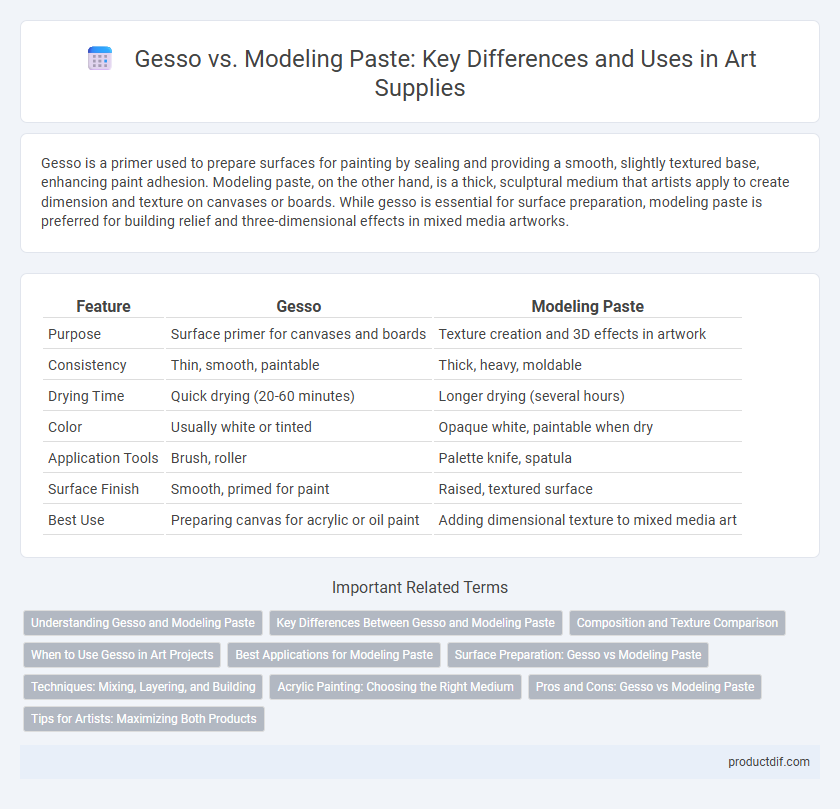Gesso is a primer used to prepare surfaces for painting by sealing and providing a smooth, slightly textured base, enhancing paint adhesion. Modeling paste, on the other hand, is a thick, sculptural medium that artists apply to create dimension and texture on canvases or boards. While gesso is essential for surface preparation, modeling paste is preferred for building relief and three-dimensional effects in mixed media artworks.
Table of Comparison
| Feature | Gesso | Modeling Paste |
|---|---|---|
| Purpose | Surface primer for canvases and boards | Texture creation and 3D effects in artwork |
| Consistency | Thin, smooth, paintable | Thick, heavy, moldable |
| Drying Time | Quick drying (20-60 minutes) | Longer drying (several hours) |
| Color | Usually white or tinted | Opaque white, paintable when dry |
| Application Tools | Brush, roller | Palette knife, spatula |
| Surface Finish | Smooth, primed for paint | Raised, textured surface |
| Best Use | Preparing canvas for acrylic or oil paint | Adding dimensional texture to mixed media art |
Understanding Gesso and Modeling Paste
Gesso is a primer composed of gypsum, chalk, or pigment mixed with a binder, designed to prepare and seal surfaces like canvas or wood, providing a smooth, absorbent ground for painting. Modeling paste is a thick acrylic-based medium that adds texture and dimension to artworks, allowing artists to create raised, sculptural effects on various surfaces. Understanding the functional differences between gesso's priming qualities and modeling paste's textural capabilities is essential for optimizing art supply usage in mixed media projects.
Key Differences Between Gesso and Modeling Paste
Gesso is a primer used to prepare surfaces for painting by creating a smooth, absorbent base, while modeling paste is a thick, textured medium designed to build dimensional effects on a canvas. Gesso typically has a matte finish that enhances paint adhesion, whereas modeling paste retains its shape and texture when dried, allowing artists to sculpt and create raised surfaces. The primary difference lies in gesso's role as a preparatory layer versus modeling paste's function as a textural additive for three-dimensional artwork.
Composition and Texture Comparison
Gesso is primarily composed of a mix of acrylic polymer, calcium carbonate, and chalk, resulting in a smooth, absorbent surface ideal for priming canvases. Modeling paste contains heavier ingredients such as marble dust and acrylic polymer, giving it a thicker, more sculptural texture perfect for building raised effects and dimensional details. While gesso provides a matte, uniform base layer, modeling paste offers a gritty, dense texture that holds peaks and shapes for three-dimensional artwork.
When to Use Gesso in Art Projects
Gesso is ideal for priming canvases and other surfaces to create a smooth, absorbent base that enhances paint adhesion and prevents absorption. It works best when preparing surfaces for acrylic or oil painting, providing a consistent texture without adding significant dimension. Use gesso when you want a controlled, uniform ground that supports layering and fine detail in your artwork.
Best Applications for Modeling Paste
Modeling paste is ideal for creating textured, three-dimensional effects on canvas and mixed media artwork due to its thick, sculptural consistency that holds peaks and ridges. It is best applied with palette knives to build up surface reliefs, allowing artists to shape and carve into the dried paste for added depth and dimension. Unlike gesso, which primarily primes surfaces, modeling paste enhances tactile qualities and is perfect for impasto techniques and sculptural detailing in acrylic painting.
Surface Preparation: Gesso vs Modeling Paste
Gesso provides a smooth, absorbent surface ideal for priming canvases and preventing paint from soaking in, enhancing adhesion and longevity of artwork. Modeling paste creates a textured, dimensional surface suitable for building relief and sculptural effects, allowing artists to shape and manipulate the substrate before painting. While gesso ensures a consistent base layer, modeling paste offers versatility in surface texture and depth, catering to diverse artistic techniques.
Techniques: Mixing, Layering, and Building
Gesso provides a smooth, absorbent surface ideal for layering thin washes of paint, while modeling paste offers thick, textured build-up for sculptural effects. Mixing gesso with acrylic paint creates a versatile base that maintains flexibility, whereas modeling paste can be tinted and shaped to add dimensional relief. Layering gesso ensures even ground for subsequent layers, and applying modeling paste allows artists to build intricate, tactile surfaces that hold shape after drying.
Acrylic Painting: Choosing the Right Medium
Gesso provides a smooth, absorbent surface ideal for preparing canvases in acrylic painting, enhancing paint adhesion and durability. Modeling paste adds texture and dimension by creating thick, sculptural effects that dry hard, allowing artists to build relief on their acrylic works. Selecting between gesso and modeling paste depends on whether the goal is surface priming or adding three-dimensional texture to the artwork.
Pros and Cons: Gesso vs Modeling Paste
Gesso provides a smooth, primed surface ideal for acrylic and oil painting, enhancing paint adhesion and preventing absorbency, but it lacks texture and build. Modeling paste offers thick texture and dimensionality, perfect for creating relief effects and impasto techniques, yet it takes longer to dry and can crack if applied too thickly. Choosing between gesso and modeling paste depends on the desired surface finish and textural complexity in an artwork.
Tips for Artists: Maximizing Both Products
Artists can maximize gesso by applying it as a primer to create a smooth, absorbent surface that enhances paint adhesion and longevity. Modeling paste excels in building texture and dimensionality on canvas, allowing for sculptural effects and bold relief patterns. Combining thin layers of gesso with thicker applications of modeling paste enables artists to achieve both a stable base and dynamic three-dimensional textures in their artwork.
Gesso vs Modeling Paste Infographic

 productdif.com
productdif.com